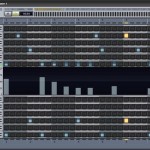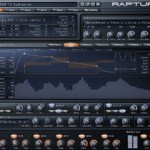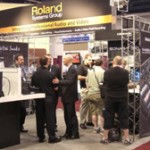For more than 80 years, The NAB Show, produced annually by the National Association of Broadcasters, has served as the premiere event for broadcast technology professionals. But there’s more to the show than just tv and radio broadcasting, it’s the ultimate educational experience! Technology professionals and solutions providers from every corner of the world, come to the show each year to explore every stage of the audio / visual content lifecycle, from creation to consumption.
Cakewalk is one of this year’s exhibitors showing off their state-of-the-art creations at the Las Vegas Convention Center in Las Vegas, Nevada from April 20 through April 23. Follow along with Robin Kelly live from the show, here on The Cakewalk Blog.
Here’s his first post:
At the Roland Systems Group booth, Zac Kenney and I were presenting the SONAR V-Studio 700 as the mixing and editing solution to the V-Mixing system. At the heart of the system, is the M-400 Digital Mixing Console from RSS by Roland. Add to that the personal monitoring system, allowing each live performer to have up to 40 individual monitor mixes and the digital snake whick allows up to 40 channels of audio over a single CAT-5 cable, and you have an extremely impressive live mixing setup.
 So how does Cakewalk’s SONAR integrate into this system? You can split the signal coming down the CAT-5 cable and connect it to the network card on your PC. Using the REAC driver, you then have 40 discreet inputs going into SONAR to record each channel individually to their own track.
So how does Cakewalk’s SONAR integrate into this system? You can split the signal coming down the CAT-5 cable and connect it to the network card on your PC. Using the REAC driver, you then have 40 discreet inputs going into SONAR to record each channel individually to their own track.
After the live show the VS-700 becomes the platform for mixing and editing the 40-track live performance. From live venues and houses of workship to broadcast customers, the feedback was extremely good. They were all impressed with the flexibility and depth the SONAR V-Studio System provides. Add to that the ability to harness and control all the power of SONAR via a hardware inferface, and you have a ‘perfect solution’. The Fantom VS is an added bonus as this provides the added ability to add extra synth tracks after recording. The ARX slot was also wowing the customers when the ARX-01 Drum card was added.
 In Las Vegas, people seem just about willing to bet on anything, but one thing no one I spoke to today was willing to gamble on was their audio. All through the day, customers were coming up to me explaining bow they prefer to mix in SONAR because it ‘just sounds better’ than other programs. Of course, it is always nice to hear such positive compliments about our flagship DAW but in a way it is extra special to hear this coming from folks who have very high (if not limitless) budgets, allowing them to choose any audio platform they wish. Even with that they are still using SONAR because of it’s quality.
In Las Vegas, people seem just about willing to bet on anything, but one thing no one I spoke to today was willing to gamble on was their audio. All through the day, customers were coming up to me explaining bow they prefer to mix in SONAR because it ‘just sounds better’ than other programs. Of course, it is always nice to hear such positive compliments about our flagship DAW but in a way it is extra special to hear this coming from folks who have very high (if not limitless) budgets, allowing them to choose any audio platform they wish. Even with that they are still using SONAR because of it’s quality.
It makes sense if you think about it. SONAR has a 64-bit double precision audio engine, multiple gain stages, and 64-bit/convolution plugins to sweeten the mix.
So YES. In Vegas, people will gamble on just about anything, anything but their audio quality!
That’s it for now. Day 2 starts tomorrow!
Robin Kelly
Cakewalk’s Director of Worldwide MI Sales
 So how does one of the top television-scoring professionals in the business get to where he is today?
So how does one of the top television-scoring professionals in the business get to where he is today? 






